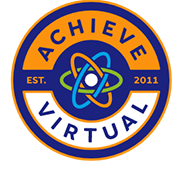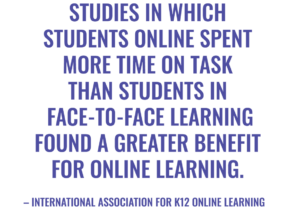Moving into the technological world of tomorrow, virtual learning is becoming more common and, in some ways, a necessity. With more and more studies focusing on the benefits and weaknesses of online learning versus a traditional high school education, students and parents can know what may work for them. There is now the decision to move further with virtual education and leave the traditional course in the past. But are virtual high schools as effective as traditional ones? What are the benefits and weaknesses that the studies have found? And finally, what does the future of education look like for the modern student?

The Benefits
One of the main benefits of virtual high schools is that students can learn according to their learning style. Traditional learning models within a traditional school can sometimes inhibit a student’s learning experience. For some, learning in their own space on a different schedule at a comfortable pace can be more beneficial than harmful to their education. Virtual high schools also allow students to focus more of their time on subjects that they may struggle with. It also allows a student to take on a full-time or part-time job if necessary.
Another benefit to virtual school learning is that schooling goes with the student wherever they need it to. Whether it’s to work or a coffee shop outside of the home, they can create their own learning space. In addition, a traditional high school means the added pressure from the environment itself, outside of the education. High schools breed social anxiety, behavioral issues, and mental health issues, among other things. In addition, students who may have learning disabilities or visual and hearing disabilities can work in a way that can be customized to what works best for them. Without the fueling of issues, students can focus solely on their education.
Virtual high schools also set a student up with skills they will likely need in the future, in college and adult life. Virtual schooling requires a student to learn what works for them and manage themselves. It teaches them to take responsibility for their education, staying focused and motivated on their own. In addition, many universities and colleges offer online courses.
Therefore online high school courses prepare them for further education. The skills that can be learned with online schooling can help students navigate the software, communicate through virtual platforms, and work without someone standing over their shoulder. Growing connections in the virtual world are becoming essential in the world’s technologically driven reality. Maintaining and nurturing virtual connections is a significant life skill that can be learned and needed later in the student’s life.
In a traditional high school, parent involvement is limited. Parents can be involved in homework assignments, parent-teacher conferences, and the occasional field trip. With the virtual learning experience, parents can be much more involved. While this may not be ideal for parents who work full-time or for students who may not have a solid parental structure at home, some parents may see this as a major benefit.
The Weaknesses of Virtual High School
When students are transferring from the classroom to their living room, they lose access to all the resources schools have to offer. Not only do some schools not have access to the resources to support virtual learning, but students may not have the resources to support it at home. And if the student does not have the resources and the school cannot supply them, the student will possibly miss out on receiving the education they deserve. In addition, the students and instructors must have some computer literacy beforehand. While it is common for students of this age to have this already, it may not translate to the instructor.
Eliminating social distractions that come with high school, students also lose the social aspects of traditional school when they are virtually learning. The social element of school makes a huge impact on the student’s development. While the effects can be damaging, some students thrive in the social atmosphere high school promotes. Some students may be dependent learners. This means they need someone there to push them and motivate them. Without an instructor or the extra support they can receive from the administration of a school, they may struggle and fall behind on their education.
Sometimes technology is not reliable. Whether it’s due to a computer breaking or the internet connection cutting out, it completely derails the lesson once an issue arises. When technology is the sole source of education, it can be detrimental when the technology fails. While it isn’t necessarily inevitable, it is still possible every time the student or instructor logs on to start schooling.
While virtual learning creates a new environment for students that could help them, it can also become an issue. In smaller classes, it is easier for the student to get the attention they need from the instructor online. However, it is harder to manage with larger classes. The students may get lost in the shuffle, causing their education to suffer. Learning in-person in a large class setting cannot always translate to a virtual environment smoothly. Virtual courses also lose the opportunity for group work, helping the student learn the skill of working with others. While this can be attempted through virtual learning, the execution is different from breaking into groups in person.
Education that is more hands-on may suffer from virtual learning as well. When it comes to the sciences, most schools require a laboratory portion of the course. This enables the students to see and learn things that cannot be comprehended on a page of the textbook. Without an in-person experience such as this, the student may not understand concepts as well. Additionally, suppose a laboratory experience is attempted to be constructed outside the classroom setting and done virtually. In that case, there is potential for disaster as some of these experiences can be quite complex.
The idea of choosing the educational environment may help a student thrive, but without the traditional high school setting in a classroom, the student is subject to major distractions. If the learning environment chosen is not ideal, the student could end up losing too much focus. The virtual learning environment is not enough to hold the total concentration on its own when there is no one to keep the structure around the student.
What Do the Studies Say?
Studies done to record statistics related to online vs. traditional high schools show results, but they are short-term results. There is no way to know the long-term results at this point when online learning is just starting to be the main course of education people are turning to. Technology advances are considerable, but student performance is questionable.
Florida is a state that requires high school students to take at least one virtual course before graduating. A study that looked at online course taking in Florida found that the online setting tended to be less effective than an in-person course. While there were potential benefits, there were downfalls.
Virtual learning enables students to make up for work they fell behind on or a course they didn’t do well on the first time. It gives students a second chance because it enables the school to provide these students with a virtual setting. However, a study that looked at public schools in Chicago and their recovery courses noted that students that took the recovery course online scored lower than those who took the course in person.
The Future of Education
The choice between a virtual education and a traditional one is ultimately up to both the parent and students. Moreover, the student and parent won’t know what will make their education thrive unless it is tried. Virtual classes are conclusively better than no classes. And for some students, traditional high school education does not fit the life they are living.
Virtual education is allowing the student to access knowledge that is not accessible in a traditional setting. The ability to access lessons, exercises, and interact with instructors in a virtual setting is now changing as virtual education enters the forefront.
With the technology and the ability to embrace it, we will be able to improve it. And while it may not become the main form of education because traditional schools have benefits that may outweigh the benefits of virtual learning, it can become a solid education choice for those students and parents who think it is what is most beneficial for the student. Ultimately, the effectiveness of virtual high schools compared to traditional ones lies in the student’s abilities—to uphold the structure and the drive to keep up with it.


